Apricots, problems
-
Eutypa dieback—Eutypa lata
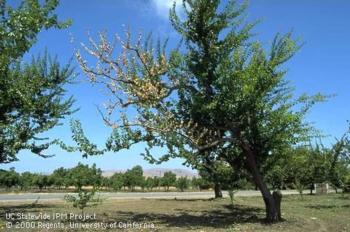
Eutypa dieback, also known as Cytosporina, gummosis, and limb dieback, causes limbs or twigs to wilt and die suddenly in late spring or summer with the leaves still attached. Rough dark cankers may develop at pruning wounds. The bark has a dark discoloration with amber-colored gumming.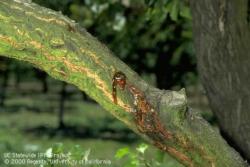
Solutions
Eutypa dieback occurs when fungus spores are spread by rain and infect trees through pruning wounds. Remove infected limbs at least 1 foot below any sign of the disease. Prune during July and August after harvest. Ideally, pruning should be completed at least 6 weeks before the first fall rains. Wound treatments with fungicides, paints, or sealants have not been satisfactory. Cauterizing freshly pruned branches with a hand-held propane burner may prevent infection.Brown rot—Monilinia spp.
Blossoms on plants infected with brown rot fungus turn brown and wither. Dead blossoms often cling to twigs for a long time. Sunken, brown areas may develop around twigs at the base of infected flowers, causing leaves at the tips of twigs to shrivel up. Brown, sticky droplets of gum may exude from the base of dead flowers and the bark of infected twigs. Velvety gray or tan tufts of spores are formed on diseased blossoms or twig cankers. Brown or tan spots spread rapidly over the fruit surface and produce spores.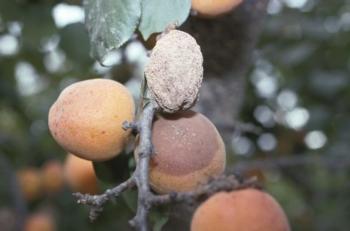
Seasonal development and life cycle—Brown rot
The fungus that causes brown rot survives the winter in infected twigs, inside dead, blighted blossoms that remain on the tree, or in dried, rotted fruit on the tree or on the ground. Spores are carried through the air by wind and splashing water to infect flowers in the spring.
Fruit is most susceptible to infection by the brown rot fungus when it is ripe. Most fruit rot develops during the month before harvest, although rot occasionally may develop on green fruit in early summer.Solutions
Remove and destroy fruit mummies and diseased plant parts promptly. This prevents the build-up of the fungus and helps keep rot below damaging levels. Prune trees to allow good ventilation. Furrow irrigate or use low-angle sprinklers to avoid wetting blossoms, foliage, and fruit. Plant varieties that are least susceptible; check with your local nurseryman.If you have had problems in the past, applications of copper-containing or synthetic fungicides such as myclobutanil at pink bud stage can help avoid serious losses. Additional applications when fruit starts to color may be needed if rainy weather persists. Do not apply copper compounds after bloom.
Read more about copper-containing fungicides.
Read more about myclobutanil.Shot hole disease (Coryneum blight)—Wilsonomyces carpophilus
Shot hole, or Coryneum blight, is a serious fungal disease of almonds, apricots, nectarines, peaches, and other Prunus species in California. Reddish or purplish brown spots about 0.10 inch in diameter occur on new leaves and shoots. The spots expand and their centers turn brown. Tiny, dark specks sometimes form in the center of lesions, especially on leaves. Spots on young leaves have a narrow, light green or yellow margin and their centers often fall out as leaves expand, leaving "shot holes." Buds of peach, nectarine, and sometimes apricot are killed in the winter. Fruit may become rough and corky. Spotting occurs on the upper surface. Concentric lesions may develop on branches.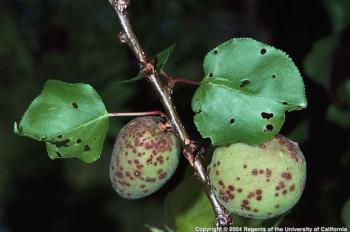
Life Cycle
Solutions
Prune and dispose of infected tissue as soon as it appears. After leaf drop, inspect plants carefully and prune infected buds and twigs with lesions. Diligent sanitation and water management can provide adequate control where the incidence of shot hole is low. Avoid overhead sprinklers or use a low angle to avoid wetting foliage. Also, some varieties may be less susceptible. Where disease incidence is high, fungicides such as Bordeaux mixtures or fixed coppers may be applied. On peaches and nectarines, a dormant spray of copper in late fall will work well.Peach twig borer—Anarsia lineatella
Peach twig borer is a pest of apricots as well as peaches, nectarines and other stone fruit. Peach twig borer larvae are dirty white or light brown with a black head when they first hatch. The body turns chocolate brown as it grows and the white portions between each body segment give the appearance of bands. Mature larvae grow to about 0.5 inch.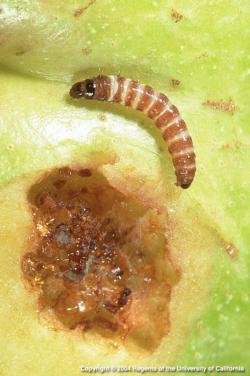
Identification of speciesLife cycle
Damage
Larvae bore into the growing shoots of twigs and ripening fruit or nuts. Shoots and leaves wilt and die back one to several inches from the growing tips of twigs. In fleshy fruit, injury is usually superficial.
Solutions
Tolerate low levels of damage. The most reliable control for peach twig borer is a dormant spray of spinosador spinosad and oil, applied in winter to kill overwintering caterpillars on the tree branches. Spinosad or Bacillus thuringiensis, applied just as trees bloom and again a week later, also controls the pest. Avoid spraying during the growing season because it is difficult to time pesticide applications effectively. Sprays must be applied to control hatching larvae before they enter twigs or fruit.Read about other pests and diseases of apricots.





